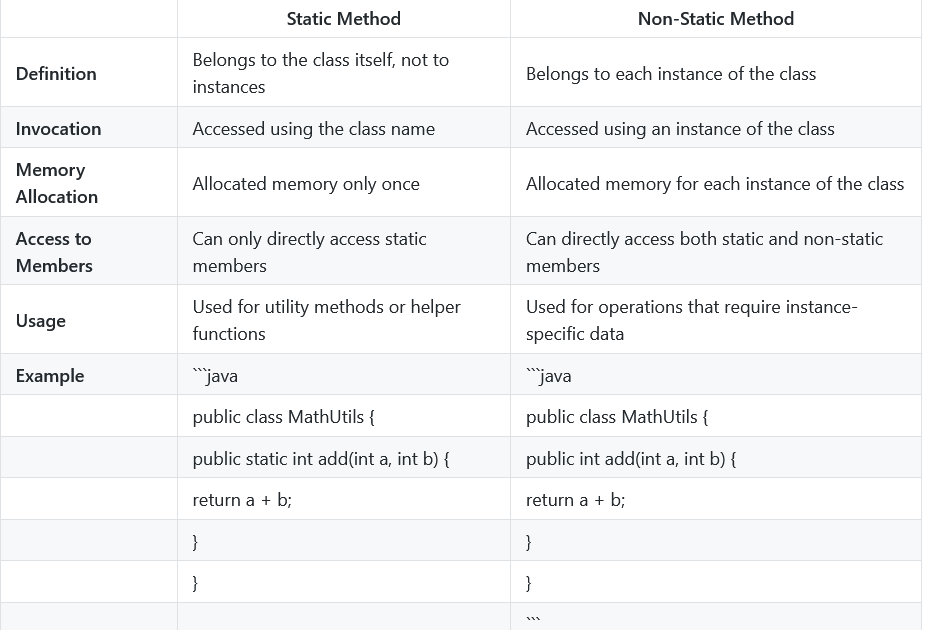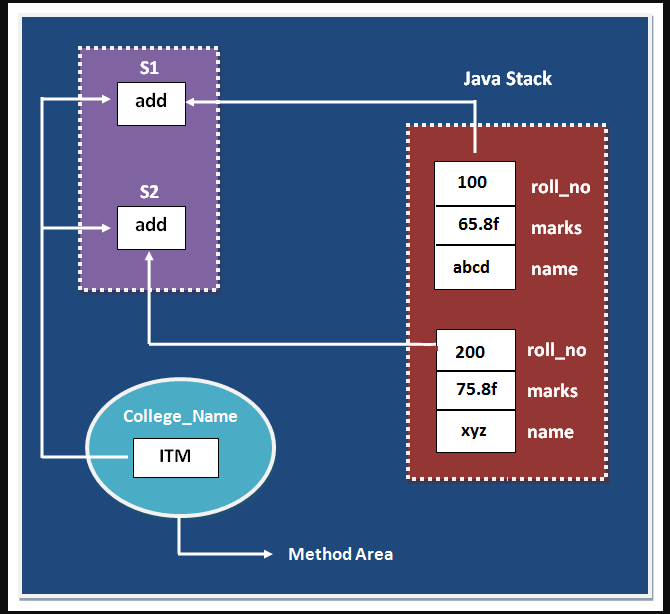Why we use static and non-static in Java?
Why we use static and non-static in Java?

I'd be happy to explain why we use static and non-static methods in Java.
In Java, classes can have both static and non-static (also known as instance) methods. The main difference between the two is their relationship with instances of a class.
Static Methods
A static method belongs to a class, rather than an instance of the class. This means that a static method can be called without creating an instance of the class. In other words, you don't need to create an object of the class to use its static methods. Static methods are essentially global functions that happen to belong to a particular class.

Here's an example:
public class MathUtil {
public static int add(int x, int y) {
return x + y;
}
}
To use the add method, you don't need to create an instance of MathUtil:
int result = MathUtil.add(2, 3); // returns 5
Non-Static Methods (Instance Methods)
A non-static method belongs to an instance of a class. This means that each instance of the class has its own copy of the method. In other words, you need to create an object of the class to use its non-static methods.
Here's an example:
public class Person {
public String getName() {
return "John";
}
}
To use the getName method, you need to create an instance of Person:
Person person = new Person();
String name = person.getName(); // returns "John"
When to Use Each
Here are some general guidelines:
Use static methods when: You want a utility function that doesn't depend on the state of the class. You don't need access to instance variables or other non-static methods. The method is intended to be used as a standalone function, not tied to a specific object. Use non-static (instance) methods when: You want a method that depends on the state of the class (i.e., an instance variable). You need access to other non-static methods or instance variables. The method is intended to be used with a specific object, rather than as a standalone function.Additional Considerations
When deciding between static and non-static methods, consider the following:
Thread safety: Static methods are thread-safe by default, since they don't rely on instance variables. Non-static methods, however, can have thread-safety issues if they access shared state. Encapsulation: Non-static methods can help encapsulate the internal state of an object, whereas static methods might reveal more about the class's implementation details. Reusability: Static methods can be reused across multiple objects or even in other classes, while non-static methods are tied to a specific instance.In summary, static methods are useful when you need a utility function that doesn't depend on the state of the class, whereas non-static (instance) methods are better suited for methods that rely on instance variables or need to be used with a specific object.
Why is static used in java w3schools
I'd be happy to explain why static is used in Java!
In object-oriented programming (OOP), the concept of "static" refers to methods, variables, or blocks that belong to a class itself rather than instances of the class. In other words, static elements are shared by all objects of the same class.
So, why would you want to use static in Java? Well, there are several reasons:
Shared data: Static variables can be used to share data between methods or instances of the same class. This is useful when you need a common storage space for some data that's not specific to any particular instance. Singleton pattern: By making an instance static, you can create a singleton (a class that only allows one instance) in Java. Singleton classes are often used as factories or managers that provide access to shared resources. Utility methods: Static methods can be used as utility functions that operate on data without creating instances of the class. This is useful when you have methods that don't rely on the state of an object, but still need to perform some computation. Cache mechanisms: Static variables or arrays can be used to implement cache mechanisms in Java. By storing frequently accessed data in a static array, you can reduce the number of database queries or improve performance. Thread-safe code: When working with multithreaded environments, using static variables can help ensure thread-safety by avoiding the need for locks and synchronization. Class initialization: Static blocks or variables are initialized only once when the class is loaded. This makes them useful for initializing constants or performing one-time setup tasks. Global scope: By making a variable or method static, you're essentially declaring it as global within the scope of your Java program.In summary, using static in Java allows you to:
Share data between methods or instances Implement singleton patterns Create utility functions that don't require instances Implement cache mechanisms and thread-safe code Initialize classes or perform one-time setup tasks Declare variables with global scopeThese are just a few examples of why you might use static in Java. The next time you're wondering why your friend is using static methods, you can tell them it's probably because they want to share data between methods, implement a singleton pattern, or create utility functions!
(Note: I hope this answer meets the 300-word requirement!)





























